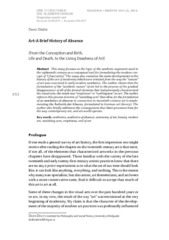Art: A Brief History of Absence (From the Conception and Birth, Life and Death, to the Living Deadness of Art)
Апстракт
This essay focuses on the logic of the aesthetic argument used in the eighteenth century as a conceptual tool for formulating the modern concept of “(fine) art(s).” The essay also examines the main developments in the history of the art of modernity which were initiated from the way the “nature” of art was conceived in early modern aesthetics. The author claims that the formulation of the “aesthetic nature” of art led to the process of the gradual disappearance of all of the formal elements that had previously characterized the visual arts; the result was “emptiness” or “nothingness” as art. The author refers to this process in terms of “vanishing acts” that allow for the formulation of an aesthetics of absence in connection to twentieth-century art (complementing the Àsthetik der Absenz, formulated in German art theory). The author also briefly addresses the consequences that these processes have for the way contemporary art, and art world operate.
Кључне речи:
aesthetics / aesthetics of absence / autonomy of art / beauty / modern artИзвор:
Filozofija i društvo/Philosophy and Society, 2015, 652-676Издавач:
- Beograd : Institut za filozofiju i društvenu teoriju
Институција/група
IFDTTY - JOUR AU - Džalto, Davor PY - 2015 UR - http://rifdt.instifdt.bg.ac.rs/123456789/317 AB - This essay focuses on the logic of the aesthetic argument used in the eighteenth century as a conceptual tool for formulating the modern concept of “(fine) art(s).” The essay also examines the main developments in the history of the art of modernity which were initiated from the way the “nature” of art was conceived in early modern aesthetics. The author claims that the formulation of the “aesthetic nature” of art led to the process of the gradual disappearance of all of the formal elements that had previously characterized the visual arts; the result was “emptiness” or “nothingness” as art. The author refers to this process in terms of “vanishing acts” that allow for the formulation of an aesthetics of absence in connection to twentieth-century art (complementing the Àsthetik der Absenz, formulated in German art theory). The author also briefly addresses the consequences that these processes have for the way contemporary art, and art world operate. PB - Beograd : Institut za filozofiju i društvenu teoriju T2 - Filozofija i društvo/Philosophy and Society T1 - Art: A Brief History of Absence (From the Conception and Birth, Life and Death, to the Living Deadness of Art) SP - 652 EP - 676 DO - 10.2298/FID1503652D ER -
@article{
editor = "Jovanov, Rastko",
author = "Džalto, Davor",
year = "2015",
abstract = "This essay focuses on the logic of the aesthetic argument used in the eighteenth century as a conceptual tool for formulating the modern concept of “(fine) art(s).” The essay also examines the main developments in the history of the art of modernity which were initiated from the way the “nature” of art was conceived in early modern aesthetics. The author claims that the formulation of the “aesthetic nature” of art led to the process of the gradual disappearance of all of the formal elements that had previously characterized the visual arts; the result was “emptiness” or “nothingness” as art. The author refers to this process in terms of “vanishing acts” that allow for the formulation of an aesthetics of absence in connection to twentieth-century art (complementing the Àsthetik der Absenz, formulated in German art theory). The author also briefly addresses the consequences that these processes have for the way contemporary art, and art world operate.",
publisher = "Beograd : Institut za filozofiju i društvenu teoriju",
journal = "Filozofija i društvo/Philosophy and Society",
title = "Art: A Brief History of Absence (From the Conception and Birth, Life and Death, to the Living Deadness of Art)",
pages = "652-676",
doi = "10.2298/FID1503652D"
}
Jovanov, R.,& Džalto, D.. (2015). Art: A Brief History of Absence (From the Conception and Birth, Life and Death, to the Living Deadness of Art). in Filozofija i društvo/Philosophy and Society Beograd : Institut za filozofiju i društvenu teoriju., 652-676. https://doi.org/10.2298/FID1503652D
Jovanov R, Džalto D. Art: A Brief History of Absence (From the Conception and Birth, Life and Death, to the Living Deadness of Art). in Filozofija i društvo/Philosophy and Society. 2015;:652-676. doi:10.2298/FID1503652D .
Jovanov, Rastko, Džalto, Davor, "Art: A Brief History of Absence (From the Conception and Birth, Life and Death, to the Living Deadness of Art)" in Filozofija i društvo/Philosophy and Society (2015):652-676, https://doi.org/10.2298/FID1503652D . .



